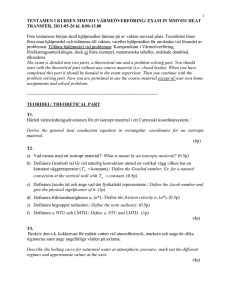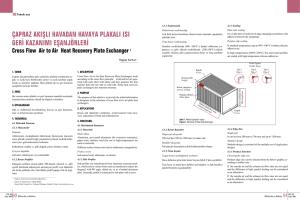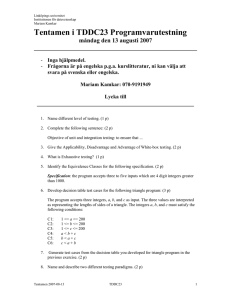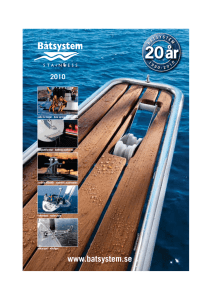2013 - Värmeöverföring
advertisement
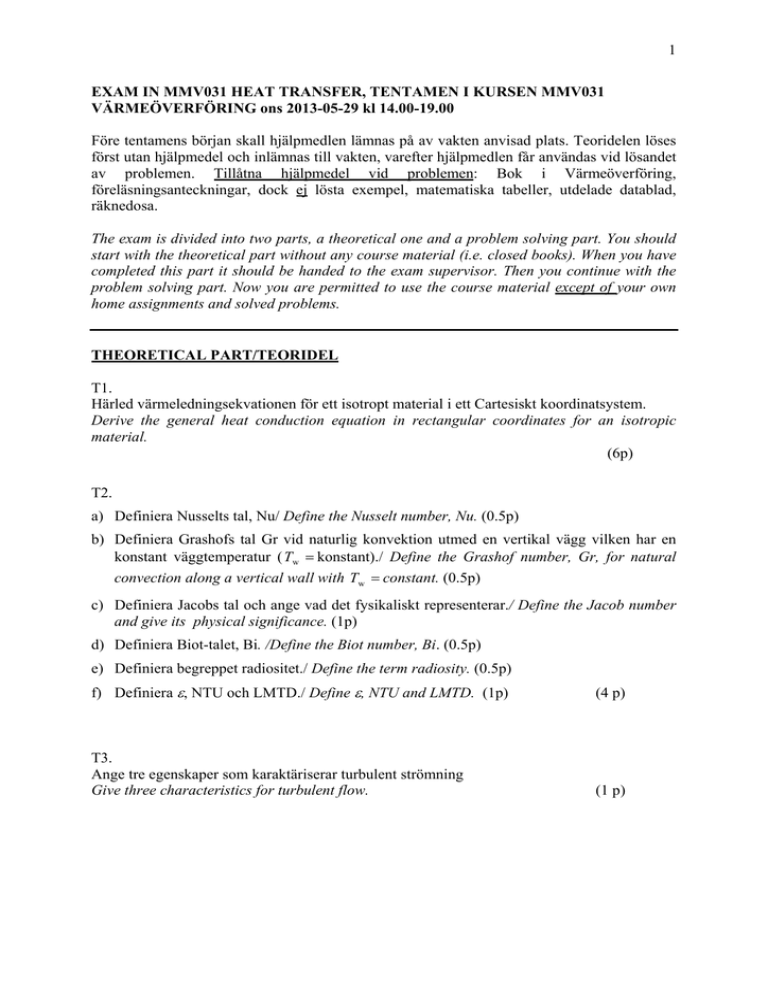
1 EXAM IN MMV031 HEAT TRANSFER, TENTAMEN I KURSEN MMV031 VÄRMEÖVERFÖRING ons 2013-05-29 kl 14.00-19.00 Före tentamens början skall hjälpmedlen lämnas på av vakten anvisad plats. Teoridelen löses först utan hjälpmedel och inlämnas till vakten, varefter hjälpmedlen får användas vid lösandet av problemen. Tillåtna hjälpmedel vid problemen: Bok i Värmeöverföring, föreläsningsanteckningar, dock ej lösta exempel, matematiska tabeller, utdelade datablad, räknedosa. The exam is divided into two parts, a theoretical one and a problem solving part. You should start with the theoretical part without any course material (i.e. closed books). When you have completed this part it should be handed to the exam supervisor. Then you continue with the problem solving part. Now you are permitted to use the course material except of your own home assignments and solved problems. THEORETICAL PART/TEORIDEL T1. Härled värmeledningsekvationen för ett isotropt material i ett Cartesiskt koordinatsystem. Derive the general heat conduction equation in rectangular coordinates for an isotropic material. (6p) T2. a) Definiera Nusselts tal, Nu/ Define the Nusselt number, Nu. (0.5p) b) Definiera Grashofs tal Gr vid naturlig konvektion utmed en vertikal vägg vilken har en konstant väggtemperatur ( Tw konstant)./ Define the Grashof number, Gr, for natural convection along a vertical wall with Tw constant. (0.5p) c) Definiera Jacobs tal och ange vad det fysikaliskt representerar./ Define the Jacob number and give its physical significance. (1p) d) Definiera Biot-talet, Bi. /Define the Biot number, Bi. (0.5p) e) Definiera begreppet radiositet./ Define the term radiosity. (0.5p) f) Definiera , NTU och LMTD./ Define , NTU and LMTD. (1p) (4 p) T3. Ange tre egenskaper som karaktäriserar turbulent strömning Give three characteristics for turbulent flow. (1 p) 2 T4. Tolka resultaten i Fig 7-4. Speciellt för ≤ -0.5 Interpret the results presented in Fig. 7-4. Particular for ≤ -0.5 (3 p) 1 0.8 0.6 0.4 0.2 0 0 1 2 3 4 T5. Varför blir NuD = 2 vid Re = 0 för sfäriska objekt Why is NuD = 2 at Re = 0 for sperical objects (2 p) T6. Vid konvektiv värmeövergång i cirkulera rör gäller ibland NuD = 3.656 och ibland NuD = 4.364. Ange under vilka villkor respektive formel gäller. For convective heat transfer in circular tubes the following relations may apply Nu D 3.656 and Nu D 4.364 . Give the conditions to be satisfied for each of the relations to be (2.5 p) applicable. T7. För rektangulära och triangulära flänsar gäller för en s.k. optimal fläns L 2 c1 b/2 b Hur lyder optimeringskriteriet? For an optimal fin the following relation applies L 2 c1 b/2 b What is the optimization criterion? (1.5 p) 3 PROBLEM SOLVING PART/PROBLEMDEL P1. Luft anströmmar en plan platta tangentiellt. Anströmningshastigheten är 7 m/s och temperaturen 30C. Plattytan hålls vid temperaturen 70C och plattans längd i strömningsriktningen är 6 m. Bestäm värmeflödet per breddenhet (W/m). An airstream is flowing along a flat plate with the approach velocity 7 m/s and the approach temperature 30C. The plate surface is kept at 70C and the plate length is 6 m. Determine the total heat flow per unit width (W/m). (10 p) P2. Ett kubiskt rum har sidan 0.6 m och dess innerväggar kan anses vara svarta. Gasen i rummet består av 25 % (volym) H2O-ånga samt N2 and He. Totaltrycket är 1 atm och gasblandningens temperatur är 1600oC. Beräkna värmeutbyte mellan gasen och rummets väggar p g a termisk strålning (endast H2O deltar i strålningsutbytet) om väggarnas temperatur är 450oC. A cubic room has a side length of 0.6 m and its inner walls can be considered as black. The gas mixture in the room consists of 25 % (volume) H2O-vapor and N2 and He. The total pressure is 1 atm and the temperature of the gas mixture is 1600oC. Calculate the heat exchange between the gas and the walls due to thermal radiation (only H2O participates) if the walls are maintained at the temperature 450oC. (10 p) P3. 12 kg/s H2O skall uppvärmas från 25C till 50C i en tubvärmeväxlare. Vattnet är på tubsidan och strömningshastigheten i tuberna är 1.0 m/s. Värmeväxlaren har ett mantelpass och på mantelsidan strömmar het olja med massflöde 8.5 kg/s och inloppstemperaturen 110C. Av praktiska skäl får tuberna inte vara längre än 10 m. Bestäm antalet tuber, antalet tubpass samt tublängden. Tubdiametern är di = 0.021 m och materialtjockleken är 1.5 mm. För H2O gäller cp = 4.2 kJ/kgK och för oljan cp = 2.3 kJ/kgK. Värmeövergångskoefficienterna är: tubsidan 2300 W/m2K, mantelsidan 1100 W/m2K. Tubmaterialet har = 35 W/mK. 12 kg/s H2O is to be heated from 25C to 50C in a shell-and-tube heat exchanger. The water is on the tube side and the flow velocity in a tube is 1.0 m/s. The heat exchanger has one shell pass and on the shell side hot oil is flowing at a flow rate of 8.5 kg/s with the inlet temperature 110C. Due to some practical aspect the tube length should be less than 10 m. Determine the number of tubes, number of tube passes and the tube length. The tube diameter is di = 0.021 m and the tube wall thickness is 1.5 mm. For H2O cp = 4.2 kJ/kgK, for oil cp = 2.3 kJ/kgK. The heat transfer coefficients are: tube side 2300 W/m2K, shell side 1100 W/m2/K. The tube material has = 35 W/mK. (10 p) 4 Maximal poängsumma är 50 p. Maximum number of credit points is 50 p. Lund 2013-05-29 Martin Andersson Bengt Sundén
